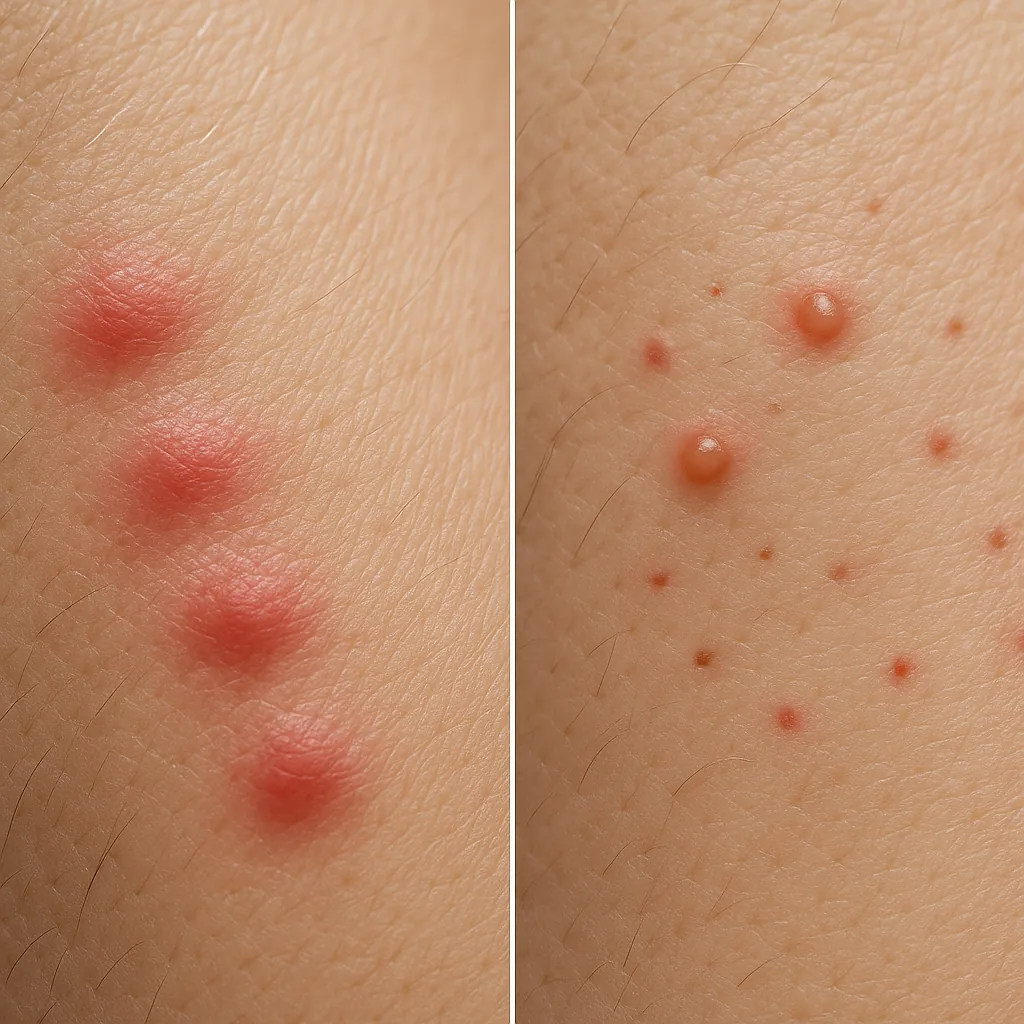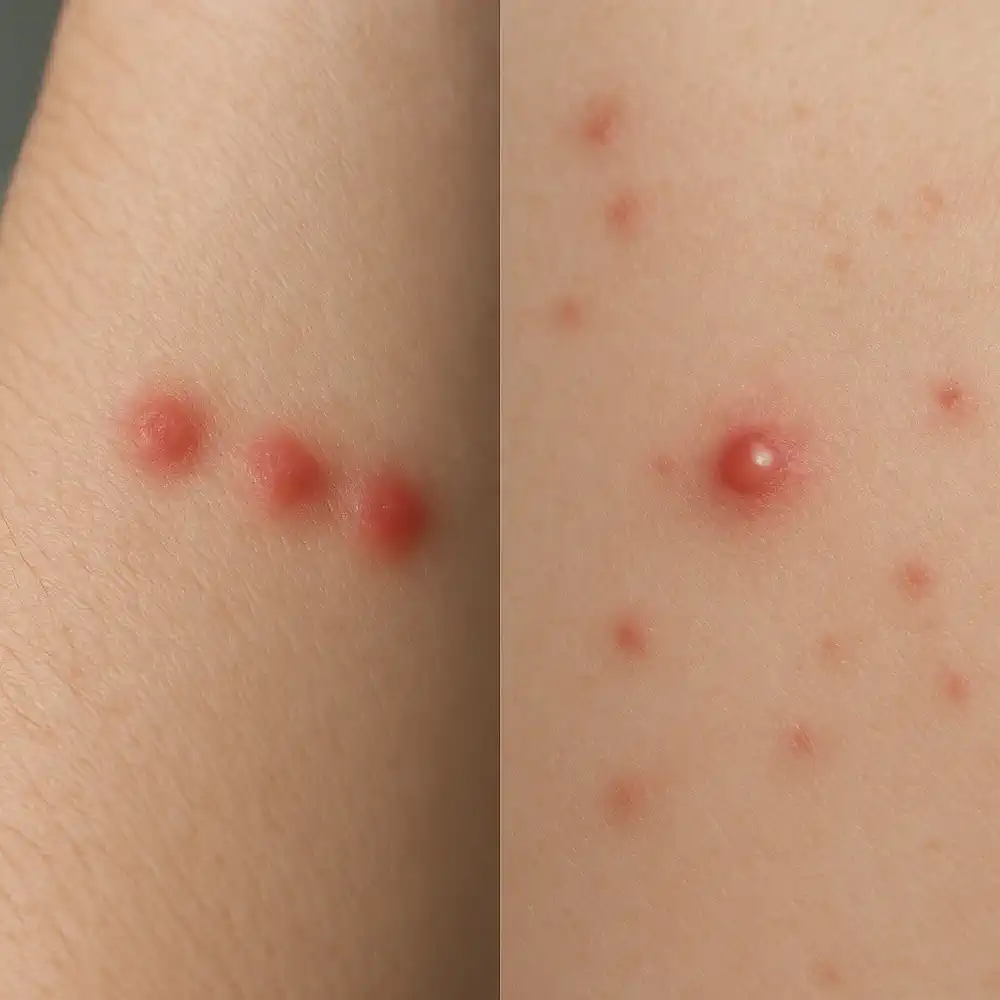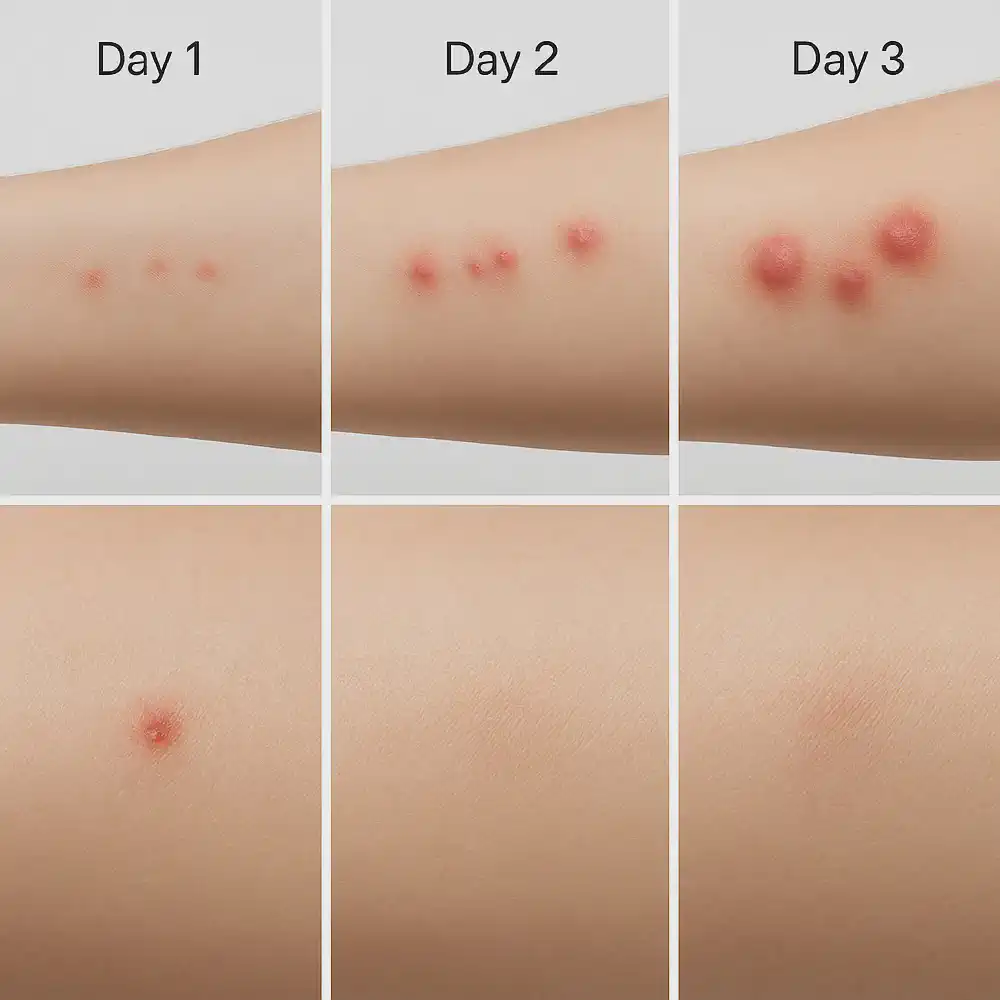
Do Bed Bug Bites Look Like Ant Bites? Expert Comparison + Free AI Analysis
Do bed bug bites look like ant bites? Yes, they can appear similar initially—both create red, inflamed marks that itch. However, professional pest control experts distinguish them by examining three key factors: bite patterns (bed bugs create linear clusters vs. ant bites appearing randomly), timing (bed bug bites appear overnight while ant bites happen during active contact), and sensation (ant bites often sting immediately while bed bug bites develop delayed itching). Understanding these bite characteristics prevents misidentification and ensures you target the correct pest before an infestation spreads.
Think These Might Be Bed Bug Bites?
Upload bite photos—confirm if patterns match bed bug feeding or ant encounters.
Need Quick Bite Analysis?
Chat with our system to assess your bite symptoms and timing patterns.
Detailed Bite Pattern Analysis

Bed bug bite patterns follow predictable characteristics: Adult bed bugs typically create 3-5 bite marks in straight lines or tight clusters, often called “breakfast, lunch, and dinner” patterns. These bites measure 2-5mm in diameter, appear as raised red welts with darker centers, and develop 1-3 days after feeding. The bites commonly occur on exposed skin areas during sleep—arms, shoulders, neck, and face—following the edges of clothing or bedding contact points.
Ant bite patterns are distinctly different: Most household ants create single, isolated bite marks that appear immediately upon contact. Fire ant bites develop into 2-4mm pustules within 24 hours, while common black ants produce small red dots that fade quickly. Ant bites occur randomly across any exposed skin during active encounters, lacking the systematic linear patterns characteristic of bed bug feeding. This confusion between ant and bed bug bites becomes especially common in travel situations—learn more about why bed bugs are mistaken for ants in hotels where bite identification challenges increase.
Professional identification focuses on bite distribution: Bed bugs feed in methodical patterns as they move across skin, creating recognizable trails. Ant encounters result in scattered, defensive bites when humans disturb their paths or nests. The systematic nature of bed bug bite placement versus the random defensive nature of ant bites provides the clearest identification distinction.
Found Bite Patterns Like These?
Found systematic linear bite patterns or tight clusters on exposed skin areas? Upload photos of these specific bite arrangements—our AI analyzes the spacing, distribution, and characteristics that distinguish bed bug feeding patterns from random ant encounters.
Unsure About Your Bite Patterns?
Experiencing scattered bite marks or immediate stinging sensations during daily activities? Chat with our diagnostic system to determine if your bite timing, location patterns, and symptoms match ant encounters or bed bug infestations.
Timing and Development Differences

Bed bug bite timing creates distinct identification clues: Bites appear exclusively after sleep periods, developing visible symptoms 1-72 hours post-feeding. The delayed reaction means you wake up with new marks that weren’t present before bed. Bed bug bites intensify over 2-3 days, reaching peak redness and swelling before gradually fading over 1-2 weeks. The nocturnal feeding schedule creates a clear timeline pattern for identification.
Bed bug bite development follows immediate contact patterns: Stinging sensations occur instantly during ant encounters, with visible marks appearing within minutes. Pain peaks immediately and subsides within hours, while visible marks typically fade within 24-48 hours for common ants. Fire ant bites develop pustules within 6-24 hours but still follow the immediate-contact timeline. Young bed bugs (nymphs) can create particularly confusing bite patterns since they’re smaller and may produce lighter initial marks—see our guide on do bed bug nymphs look like ants for identifying early-stage bite characteristics.
For comprehensive identification of the actual insects causing these bites, see our detailed guide on Do Bed Bugs Look Like Ants? covering physical characteristics, behavior patterns, and habitat differences between these commonly confused pests.
Quick Comparison: Bed Bug Bites vs Ant Bites
| Characteristic | Bed Bug Bites | Ant Bites | Fire Ant Bites |
|---|---|---|---|
| Pattern | Linear clusters, "breakfast, lunch, dinner" lines | Random, scattered single bites | Clusters around contact point |
| Timing | Appear after sleep, 1-72 hours delay | Immediate upon contact | Immediate sting, pustules in 24h |
| Sensation | Delayed itching, painless initially | Immediate mild sting/pain | Intense burning, severe pain |
| Location | Exposed skin during sleep (arms, neck, face) | Any exposed skin during activity | Feet, ankles, outdoor exposure |
| Duration | Peak at 2-3 days, fade over 1-2 weeks | Fade within 24-48 hours | Pustules last 3-10 days |
Armed with Bite Timing Knowledge?
Armed with this comprehensive understanding of bite timing patterns, delayed reactions, and development schedules, you're ready to take action. Upload photos if you've found systematic overnight bite patterns or chat with our system if you're experiencing immediate-contact bite scenarios during daily activities.
Ready for Expert Analysis?
Get personalized analysis combining bite characteristics, timing patterns, and next-step recommendations based on your specific situation.
Frequently Asked Questions
Frequently Asked Questions
Can ant bites be mistaken for bed bug bites?
Yes, ant bites can initially look similar to bed bug bites since both create red, itchy marks. However, ant bites appear immediately after contact and occur randomly, while bed bug bites develop overnight in linear patterns on exposed sleeping areas.
Do bed bug bites itch more than ant bites?
Bed bug bites typically develop delayed itching that intensifies over 2-3 days and can persist for weeks. Ant bites usually sting immediately but the discomfort subsides within hours, with less persistent itching overall.
How can I tell if bite marks are from bed bugs or ants?
Look for three key differences: bite patterns (bed bugs create linear clusters vs random ant bites), timing (bed bug bites appear after sleep vs immediate ant bite reactions), and location (bed bug bites on sleeping-exposed skin vs ant bites anywhere during activity).
Do fire ant bites look different from bed bug bites?
Yes, fire ant bites create immediate intense burning pain and develop into white pustules within 24 hours, while bed bug bites are painless initially with delayed itching. Fire ant bites also occur in clusters at the contact point, typically on feet and ankles during outdoor exposure.
How long should I wait to see if bites are from bed bugs or ants?
Ant bites show immediate symptoms and fade within 24-48 hours, while bed bug bites develop delayed reactions over 1-3 days and persist for 1-2 weeks. If bites appear overnight with no immediate pain and worsen over several days, they're likely bed bug bites.
Worried About Bed Bugs? Find Out Now – For Free!
Upload a picture and get instant, free detection. No guessing—just fast, accurate results. If bed bugs are found, we’ll recommend the right products and simple step-by-step treatment.
Click here to start – it’s 100% free!
Get started nowWorried About Bed Bugs? Find Out Now – For Free!
Upload a picture and get instant, free detection. No guessing—just fast, accurate results. If bed bugs are found, we’ll recommend the right products and simple step-by-step treatment.
Click here to start – it’s 100% free!
Get started now